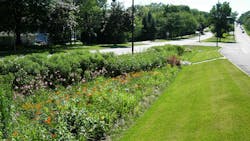Are cities building green infrastructure equitably?
The introduction of green infrastructures (GI), such as bioswales with permeable surfaces, has provided municipalities with a new tool to manage flood risk associated with rainfall. Cities including Portland, Phoenix, and Atlanta have developed plans and invested in implementing GI to mitigate the risk of floods.
New research from Portland State University combines demographic data with the distribution of GI and geographic areas prone to rainwater flooding in Portland, Phoenix, and Atlanta and asks whether these cities are mitigating flood risks equitably.
The paper, "Urban flood risk and green infrastructure: Who is exposed to risk and who benefits from investment? A case study of three U.S. cities," appears in Landscape and Urban Planning.
According to the paper's lead author Arun Pallathadka, student in the Earth, Environment and Society program at Portland State, the research team found that the placement of GI in each of the cities inconsistently overlapped with areas prone to rainwater flooding, and that non-white and low-income populations were more vulnerable to flood risk.
Portland and Phoenix have increased investments in GI in neighborhoods with higher populations of non-white and low-income residents, marking a transition to more equitable flood risk management. In Atlanta, the risk of rainwater flooding was relatively low for non-white and low-income residents, though there was a substantial disparity in GI coverage.
"Flooding is the costliest natural hazard," Pallathadka said. "But when we talk about flooding, the focus is often on the floodplain, on rivers. But with climate change, we're expecting an increase in flooding associated with rainfall events. We wanted to know where the hotspots in cities are associated with a risk of flooding from rain, who are the people living in those communities, and where are cities placing infrastructure to help reduce the hazards."
In addition to the spatial, temporal and demographic analysis, the research team developed a tool that can be used by researchers, city planners, and policymakers to categorize neighborhood risk levels. Cities can use the tool to help guide investments in GI to neighborhoods most at risk of flooding from rainfall events.
The methods deployed by the team provide cities with a novel approach to assessing the need for GI in neighborhoods prone to flooding associated with rainwater while also planning for the equitable distribution of those resources as they move ahead under the threat of increasing extreme precipitation events.
SOURCE: Portland State University, by Shaun McGillis. Edited for style and length.
